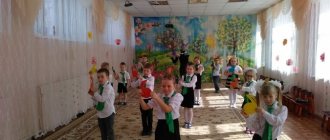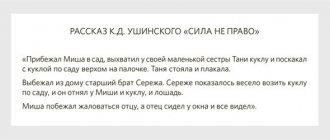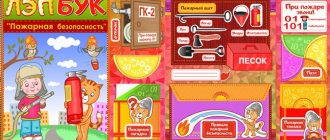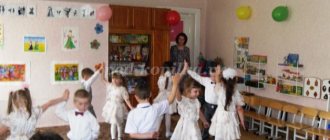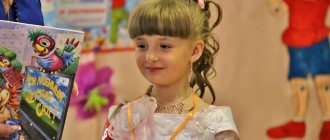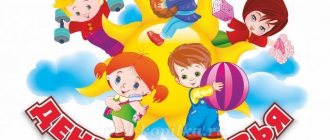Kindness Day in Kindergarten. Preparatory group
Summary of the lesson “What is kindness” for children of the preparatory group
Author: Efimova Alla Ivanovna, teacher of GBDOU No. 43, Kolpino St. Petersburg Description: the material may be of interest to teachers of senior preschool age, teachers of additional education.
GOAL: To generalize children’s idea of kindness as a valuable human quality, to develop social feelings and mutual assistance. TASKS: - Form friendly relationships; - reveal the essence of the concepts of “goodness” and “kindness”, “good deeds”; — activate children’s vocabulary (kindness, joy, happiness, care, attention); - develop logical thinking, imagination and attention in children, instill interest in a new form of play activity; — to form children’s idea of kindness, to cultivate good feelings towards the people around them, to help children understand that everyone needs love and a friendly attitude. Preliminary work: looking at illustrations, reading poems, proverbs about goodness, memorizing them, watching cartoons, reading fairy tales about goodness. The home was given the task to complete a drawing, appliqué, or craft on the topic: “What is kindness?”
PROGRESS OF THE LESSON Educator: What is kindness? Wash the cat's bowl, Give a flower a drink of water (He's terribly lonely), Fix a sister's toy, Let an old lady pass first, Treat sadness with love with words, Help a tired mother, And a stranger girl, Carry a briefcase home. From warmth and kindness, Flowers bloom, She warms everyone, Like a ray from a window. (I. Polyushko) Educator: Guys, did you like the poem? What do you think we will talk about today? Answers. Educator: What is kindness? Answers.
Educator: many writers and scientists wrote a lot of wonderful lines about kindness. Listen to some of them.
Educator: I want to read a poem to you, and you listen carefully and complete the assignment for the poem. Physical pause: If we frown in the morning, Kindness will help us. Well, kids, get together, And smile at each other.
Educator: How good, you all smiled. I would like to invite you to devote your entire day to good deeds. First, let's conduct such a lesson in our group. Child: In a group on a winter day in the morning, there was a lesson in kindness. Everyone studied diligently, And today among themselves, They didn’t share candy, But they shared kindness. All grievances were forgotten, Peace was concluded with the whole group. And they decided - from now on, there will be no quarrels. So as not to isolate ourselves, Let's all stick together, Let's keep up as a group, Let's all help each other. During the lesson of kindness, There was so much warmth, That from this warmth, All the flowers bloomed! (N. Anishina) Educator: What are good deeds? Answers. Educator: Guys, let's play the game “Good Deeds.” List what good deeds you, preschoolers, can do? Who will remember and name more of the things you did? Children take turns naming things to do and each child bends his finger (counts his completed things)
Answers: help the nanny set the table, wipe the dust on the shelves, water the flowers, put away the toys, help the younger ones (play with them, share a toy), behave well, fix the book, study well, etc.
Educator: What is needed for people to become kinder, for kindness to be everywhere? How should you start your day? Answers: with kind words and good deeds. Educator: What kind and polite words do you know? Answers.
Educator: Well done, you remembered the words, but you already say them a hundred times a day. I invite you to go out onto the mat, let’s all stand in a circle and play the game “Proverbs about Kindness.” I pass the bunny toy, and everyone takes turns saying the proverbs and passing the toy to each other.
Educator: Let's remember the rules of kindness? Answers.
Educator: Our next task is the most difficult, let's distract ourselves a little and do some gymnastics. I walk and you walk - one, two, three (step in place) I sing and you sing - one, two, three (conducting with our hands) We walk and sing - one, two, three (we walk in a circle in one direction ) We live very friendly - one, two, three (we walk in a circle in the other direction) We don’t live too hard, and we are friends with everyone (we walk in a circle, holding hands and hugging each other) Educator: Guys, the kids asked you to make a salt dough for them to give them nesting dolls so that they can decorate them and then play with them. Now I suggest you make matryoshka dolls from salt dough (which I prepared in advance), and after sleep we will take the dolls to our little friends. While you are making nesting dolls, I will ask you to write poems about goodness and good deeds. And you can also tell these poems to the kids in the evening. Child: All people need kindness, Let there be more kind ones. It’s not for nothing that they say “Good afternoon” and “Good evening” when meeting. And it’s not for nothing that we have the “Good Hour” wish. Kindness is the adornment of a person from time to time... Child: It is not at all easy to be kind, Kindness does not depend on growth. Kindness does not depend on color, Kindness is not a gingerbread, not a candy. If kindness shines like the sun, adults and children rejoice. Child: I want everyone to laugh, so that dreams always come true, so that children have joyful dreams. So that the morning is good, So that mom doesn’t be sad, So that there is no more war in the world. Child: - Good afternoon! - they told you, - Good afternoon! - you answered. How two strings connected Warmth and kindness.
Educator: What wonderful dolls the nesting dolls turned out to be, you did a great job, you deserved the treat. Let's leave our nesting dolls, let them dry, and we'll go to the site and do good deeds there and breathe some air.
Educator: Please note that in the locker rooms we have an exhibition of your works on the topic - goodness. Well done to everyone, they did a wonderful job, and everyone contributed a piece of their kindness to our group. Educator: And in the afternoon I suggest you decorate our “Tree of Goodness”.
We recommend watching:
Scenario for a holiday on the water in the preparatory group. Summary of entertainment on the basics of a healthy lifestyle in the senior and preparatory group. Entertainment in the preparatory group. Scenario for entertainment in the preparatory group.
Similar articles:
Summary of entertainment in a preparatory school group based on the works of N. Nosov
KVN script in a fire safety preparatory group for children and parents
KVN in the preparatory group on the topic “Nature around us”
Scenario of thematic entertainment in the preparatory group “Travel to the cities of Chuvashia”
Musical KVN for older preschoolers. Scenario
Summary of GCD in the senior group on the topic: Good
Summary of educational activities in the senior group on the topic: “Give kindness to people”
Author: Lyudmila Aleksandrovna Shchukina, teacher of the MBDOU “Kindergarten of a combined type No. 174”, Voronezh Description of the material : I offer you a summary of direct educational activities for children of the senior group (5-6 years) on the topic “Give kindness to people.”
This material will be useful to teachers of the senior group. This is a summary of an educational lesson aimed at developing an idea of human spiritual beauty and mental health. Summary of direct educational activities in the senior group on the topic: “Give kindness to people”
Integration of educational areas : “Social-communicative”, “Artistic-aesthetic”, “Speech”, “Cognitive”. Goal: To give children an idea of the spiritual beauty and mental health of a person. Objectives: Educational: to form an idea of the meaning of goodness for harmony and happiness.
Speech: activate the words “thank you”, “please”, “sorry” in children’s speech, develop coherent speech. Developmental: develop the ability to help and sympathize with people. Educational: to cultivate the desire to give joy and good mood to loved ones. Handouts: trays, cards with printed words “sorry”, “thank you”, “hello”, “goodbye” Methodological techniques: game, conversation, solving a problem situation, physical education, task, productive activity. GCD move
Educator: Invented by someone, simple and wise When meeting, say hello: “Good morning!” - Good morning! To the sun and birds, -Good morning! smiling faces! And everyone becomes kind and trusting. Let the good morning last until the evening! Educator : Children, I am very glad to see that you are in a good mood. We will start our day today by sending each other good thoughts, good feelings. Let's say our good wishes to each other. I have in
hands "kind heart". I want to give it to Veronica and wish her all the best. Game “Good Thoughts, Good Feelings”
Educator: I want to ask you to tell me about how you felt when you sent each other good thoughts and good feelings?
(It was fun, it became very good, I felt good, I liked it, it’s interesting to play like that...) Educator : Guys, how do you understand the proverb: “A healthy mind in a healthy body”? This proverb says that a person has a body and a soul. When the body is sick, the soul is sick too. And vice versa, if the soul is sick, the body also feels bad. What happens when the body is sick? (Headache, sore throat, difficulty walking, taking medications...) Educator: what happens to a person when his soul feels bad, what does he feel? (You’re in a bad mood, sad, sad, you’re not happy about anything...) Educator: How can you cure an unhealthy soul? (To have pity, to visit, to give something, to amuse, to give an interesting toy...) Educator : Well done, children! Say magic words to each other. If kindness lives in the world, adults and children rejoice. Proverbs about kindness - Kindness is good everywhere. “Everyone is busy, he wants what’s good for himself.” - Life is given for good deeds. - Everyone loves goodness, but not everyone loves it. “A kind person teaches good things.” - A kind word pleases the cat too. “A kind person is more likely to do something than an angry one.” Educator: Guys, remember and name which good and evil fairy-tale characters you know? (Leopold the cat and the mice, Cinderella and the stepmother, the Needlewoman and Sloth, etc.) Educator: In life, it happens that people do good and bad deeds. Let's look at life situations with you. Situations: 1. The girl is crying. During the walk, a quarrel occurred between the girls. Educator: What happened? Is it possible to help grief with tears? Girl: Nastya and I played ball. And the ball rolled into a puddle, I wanted to get the ball and fell into the puddle, Nastya began to laugh loudly, and I cried loudly. Educator: Did Nastya do the right thing? What would you do in her place? Let's help the girls make peace. Educator: If you are the culprit of the quarrel, be the first to admit guilt. Magic words will help you with this: excuse me, let me help you, let’s play together... 2. The girl sat in the wrong chair, the boy pushed her off and sat down himself. The girl began to cry. Did the boy do the right thing? What would you do in his place? Children: Ask to get up from the chair, bring her her chair... Educator: When you hear kind words, your soul becomes warmer. Goodness heals the soul. Good deeds and good thoughts are the best medicine for the soul. In order for your soul not to hurt, you must, first of all, be kind yourself. So we will play with good words and good deeds. I’ll start reading the poems, and you should complete them in unison: - Even a block of ice will melt from a warm word Children: Thank you! - The old tree stump turns green when it hears Children: Good afternoon! - If we can’t eat anymore, we will tell our mother: Thank you! — A polite and developed boy says when meeting Children: Hello! - When they scold us for pranks, we Children say: Forgive me, please! - And in Russia, in Ukraine, in Denmark, at parting, the Children say: Goodbye! Assignment: There are words in the tray. Find among the printed words a word that begins with the letter “I”, “Z”, “S” (“sorry”, “hello”, “thank you”). Find an expression that consists of two words and begins with the letter “D”. When I was walking to you, a strong wind blew, the “magic word” fell and the letters broke, I need to restore them. (Goodbye). Educator: Well done, how many magic words do you know! A kind word can cheer up every person in difficult times and dispel a bad mood. Physical education minute. Hello golden sun, Hello blue sky, Hello light breeze, Hello little oak tree, We live in the same region, I greet you all! (Perform movements in accordance with the text). Group work “Draw a heart of kindness” Educator : Children, let’s draw a big heart of kindness together (paint the heart with your fingers).
Educator: Look, now we have a “Heart of Kindness” in our group. It will send us its warmth, wish us well and help us study. I propose to call this heart of kindness the “Good Deeds Calendar.” In it we will celebrate your good deeds and actions that you have performed during the day. Now fold both hands near your chest, open your palms, imagine that they contain as many good feelings as can fit. You are very pleased to feel the warmth. Place as much goodness in your heart as possible. (Join your hands and place them on your chest.) You felt the warmth of your soul, the warmth of the hearts of everyone who is now next to you. Educator: I want you to feel good all day today. This heart can give kindness to all people, but for this you need to let it go along with your wishes. It is in our hands to make the world a kinder and happier place! (blow on your palms).
We recommend watching:
Summary of GCD in the senior group. A journey through Chukovsky's fairy tales. Notes on direct educational activities in the senior group for children with mental retardation. Notes on cognitive and research activities in the senior group. Notes on educational activities in the senior group on the topic “How to see the air.”
Similar articles:
Summary of a safety lesson in the senior group: Safety in nature
Lesson on basic safety in the senior group. Topic: Rules of conduct while walking
Life safety tasks for children 5-7 years old
Cultivating kindness in preschoolers
Maria Koryakina
Cultivating kindness in preschoolers
“ Kindness is the sun that warms a person’s soul. Everything good in nature comes from the sun, and everything good in life comes from man.”
M. Prishvin.
The relevance of the topic is beyond doubt, since the formation of this extremely important quality ( kindness )
lies at the basis of the moral
education of a preschooler . The basis of a person’s morality are those qualities that determine his moral character, make him internally free and socially valuable in all spheres of public and personal life. The foundation of this process must be laid in childhood, in preschool age .
The apt statement of L. N. Tolstoy is widely known: “From a five-year-old child to me there is one step. There is a terrible distance from the newborn to me.” V. A. Sukhomlinsky said that “ good feelings should be rooted in childhood. If good feelings are not cultivated in childhood , you will never cultivate , because truly human is established in the soul simultaneously with the knowledge of the first and most important truths. In childhood, a person must go through an emotional school - the school of instilling good feelings .”
Concepts of " kindness "
.
- Kind - doing good to others , sympathetic, and also expressing these qualities. Kind soul . Kind eyes .
- Kind - bringing goodness , kindness , well-being. Good news . Good relations .
- Kind - good , moral. Good deeds .
- Kind - friendly , close, dear.
- Kind - benevolent , responsive, ready to help people.
- Kind - willingly sharing his means, property, etc. with others; generous.
- Kind - characteristic of a benevolent , sympathetic person.
- Kind - expressing affection, sympathy.
- Kind - based on the desire for good to people ; necessary, useful.
Nurturing kindness is one of the essential aspects of raising a child . This is due to the awakening in a child of compassion, empathy in grief, misfortune and the ability to rejoice and empathize with the success of another as one’s own. The child should come to this not through reproach or fear of punishment, but through strengthening his sense of self-worth as he grows up.
The main conditions for developing friendly relationships among preschoolers are :
— creating an emotionally positive climate in the group;
- modeling pedagogical situations that allow children to show kind feelings towards others.
To form friendly relationships among students , teachers use all available forms and methods of work:
•didactic, active, role-playing, theatrical, problem and folk games;
• direct educational activities;
• modeling and analysis of given situations;
• writing stories, fairy tales, memorizing poems, nursery rhymes, jokes;
• conversations, reading fiction, asking riddles;
• viewing paintings and illustrations;
• solving crossword puzzles, entertainment, watching videos;
• organization of exhibitions of children's creativity;
• project method, etc.
Every day a child must see and comprehend the alphabet of morality in his immediate environment, including in kindergarten. To do this, I create problem situations and exercises of good deeds , practical trainings. Here are examples of some of them:
1. You are in a good mood. Why? (- mom smiles; - the sun is shining;.)
;
2. Do you need to be friends? (- with a slob; - with a child who tears up books;.)
;
3. The game “Good-Bad” - to separate good and bad actions and phenomena, that is, to take a step in the formation of kindness at the level of ideas;
4. Look at pictures depicting positive and negative situations;
5. Learning and putting into practice the poetic game “Dictionary of Polite Words” (even a block of ice will melt from the word warm “Thank you”; an old tree stump will turn green when it hears “ Good afternoon ”);
6. The game “Gifts to each other” - to form a social orientation towards other people, including the disadvantaged; and others.
Play is the best means of raising children , because it is in play that children best manifest and consolidate good feelings . The main content of children's play is to perform certain actions with toys and reproduce the actions of people ; middle-aged children – in reproducing relationships between adults; For older preschoolers, the content becomes the rules of social behavior and social relations between people. When children play, situations of kindness and attention are even easier to organize than in ordinary life. Through a certain plot, content and role during the game, you can form the moral and social feelings of preschoolers . A necessary condition for this is the modeling of relationships in which humane feelings are manifested.
The use of fiction, especially fairy tales, gives good results in teaching kindness The artistic word affects not only the consciousness, but also the feelings and actions of the child. A word can inspire a child, make him want to become better, do something good, help him understand human relationships, and get acquainted with norms of behavior. At the same time, it is important to tactfully direct the thoughts and feelings of children in the right direction. You should draw the child’s attention to morally significant moments. To do this, you need to: teach children to compare and contrast; form the habit of proving that this is so and not otherwise; putting the child in the place of the hero, thereby giving him the opportunity to choose his own position; to train children in the synchronous expression of feelings and body movements, providing deeper empathy for the actions and actions of the characters.
An effective method of developing goodwill is conversation , during which the teacher has the opportunity to draw the child’s attention to the suffering of another person. Conversation in everyday life, before, during and after play, contributes to the emergence of a response - compassion, encourages the child to find the right ways to show sympathy and provide help.
When communicating with your child, do not forget to give him examples of kindness . Raising a child should not be understood as regulating his behavior and reading him moral sermons. It is very important that the child, as early as possible, feels the reality of someone else’s suffering and empathizes with him, so that he can love, pity, forgive, and help. It is known that it is easier to teach a preschooler to instill something positive in him . Therefore, kindergarten teachers are responsible for helping those parents who quite consciously want to see their child kind , polite, etc.
to cultivate kindness and sensitivity in a child with the same, if not more, persistence and consistency as willpower. And most importantly, kindness can only be cultivated through kindness . Parents of preschoolers were offered 10 commandments:
1. Don't expect your child to be like you. Or the way you want.
2. Don’t think that the child is yours, he is God’s.
3. Do not demand payment from your child for everything you do for him. You gave him life, how can he thank you? He will give life to another - this is an irreversible law of gratitude.
4. Do not take out your grievances on a child, so that in old age you do not eat bitter bread, for what you sow is what will come back.
5. Don’t look down on his problems: the hardness of life is given to everyone within their strength, and rest assured, it’s no less hard for him than yours is for you. Or maybe more, because he doesn't have a habit.
6. Don't humiliate.
7. Don’t torment yourself if you can’t do something for your child; torment yourself if you can, but don’t do it.
8. Remember - not enough has been done for the child if everything has not been done.
9. Know how to love someone else’s child. Never do to someone else what you would not want others to do to yours.
10. Love your child in any way: untalented, unlucky, adult; when communicating with him, be happy, because a child is a holiday that is still with you.
The task of parents is to create and constantly maintain an atmosphere of love, kindness , mercy and mutual assistance in their family.
When working with parents, I used active forms and methods: parent meetings; consultations; classes with the participation of parents; exhibitions of works made together with parents; days of good deeds ; open days; active involvement of parents in the life of the kindergarten (assistance in preparing and holding holidays; creating a subject-development environment; etc.). They allowed me to solve the following tasks: activate and enrich the educational skills of parents ; establish close contact with the families of pupils .
The formation of a sense of kindness in preschoolers occurs gradually. Young children strive for good deeds, first for the sake of praise and approval from adults . Gradually, the habit of doing well, doing good , develops in them into a feeling of caring for another person, becomes their natural need. And compassion, expressed in active, selfless help to another person, in caring for him, giving up one’s personal in favor of another person, is one of the first humane feelings that awakens in preschoolers .
Bibliography:
1. Dal V.I. Explanatory dictionary of the living Great Russian language by Vladimir Dal. - St. Petersburg. – 1903
2. Kon I. S. Dictionary of ethics. - M.: Politizdat, 1981.
3. Ozhegov P.I. Dictionary of ethics. - M.: 1981
Card file of games and exercises “Lessons of Goodness” for children of senior preschool age.
Isaeva Vera Vasilievna MBDOU combined type kindergarten No. 4 Nizhny Novgorod region Vyksa
Card file of games and exercises “Lessons of Goodness” for children of senior preschool age.
Kindness is the willingness to help the little, the needy and the weak. Children are initially (as a rule) not kind and self-centered, so teaching kindness, at least as a pattern of behavior, is a step forward in the direction of the child’s socialization.
In childhood and adolescence, kindness is one of the most reliable means of turning a child and adolescent into the world of another person, cultivating responsiveness and willingness to cooperate.
Game "Flower-seven-flowered"
Target:
continue to get acquainted with the polar concepts of “good - evil”.
Material:
a seven-flowered flower, such that the petals come off (taken out of the flower), red and yellow chips.
Progress of the game:
Everyone, having picked a petal, can think of one cherished wish. You can tell others about it only when the petal “flies around the whole world.” One by one, the children with the petals spin around with the others:
Fly, fly, petal
Through the West - to the East,
Through the north, through the south, come back in a circle.
As soon as you touch the ground,
To be according to your wishes!
If the wish made is related to the satisfaction of his personal needs, the child receives a yellow chip; if it has social significance, a red chip. By collecting all the chips at the end of the game, you can determine the level of moral development of the group (but children are not told about this). At the end of the game, the teacher suggests discussing which wishes the children liked and why.
Exercise “Get Out of Trouble”
Target:
generalize children's idea of kindness and emotional states that correspond to this concept. Inspire the desire to do good deeds.
Material:
toys: Bunny and Teddy Bear, pictures depicting “evil” and “good” wizards.
Progress of the game:
The teacher invites the children to think about how they would help Mishka and Bunny out of trouble. Children make up stories that are played out with the help of toys. The teacher draws their attention to the expression on the face of the evil wizard: it has changed and become kind. (The image of the evil wizard is replaced by the corresponding one). The wizard thanks the children for rescuing his favorite toys from trouble, and says that he also wants to do something nice for them and tells them a fairy tale.
Game "Mouse and Mousetrap"
Target:
develop in children a sense of kindness, empathy, and desire to support others; develop a friendly attitude towards animals.
Progress of the game:
the required number of players is 5-6. Everyone forms a circle, presses tightly against each other with their legs, hips, shoulders and hugs their neighbor around the waist - this is a “mousetrap” (or net). The driver is in a circle. His task is to get out of the “mousetrap” in every possible way: to find a “hole”, to persuade someone to move the players apart, to find other ways of action. At the same time, the teacher makes sure that the legs of the “mousetrap” do not kick the mouse or hurt it. If the teacher notices that the mouse is sad and can’t get out, he regulates the situation, for example: “Let’s all help the mouse together, relax his legs and arms, take pity on him.”

